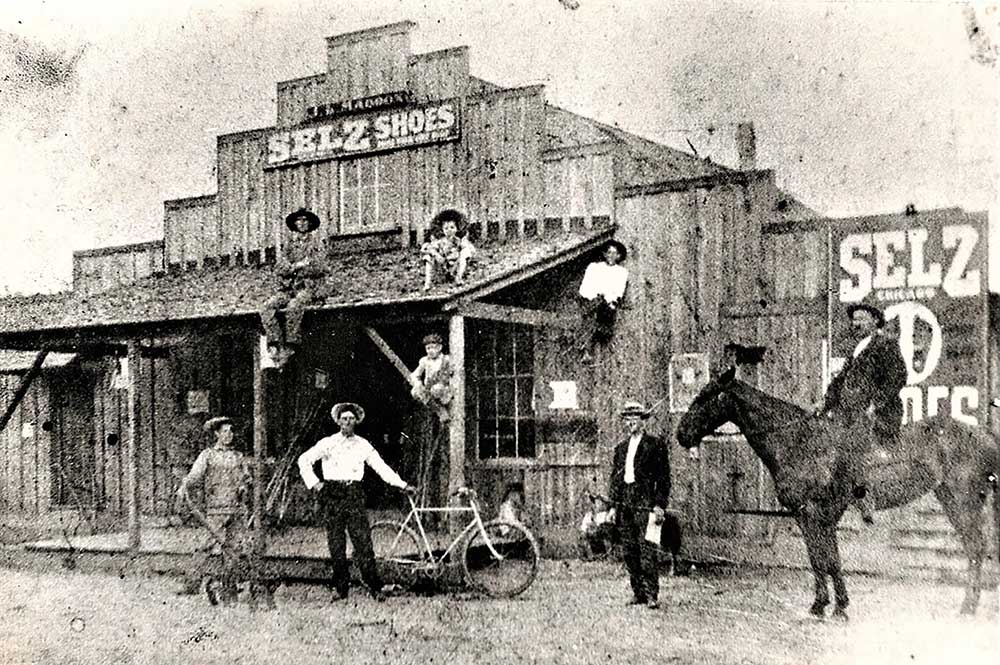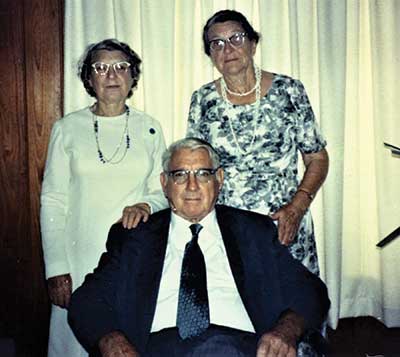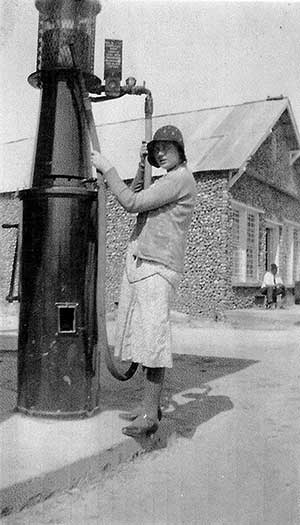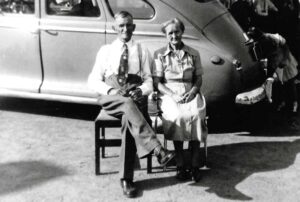
Name reveals storied past of
Odenville entrepreneur
Story by Joe Whitten
Photos by Wallace Bromberg Jr.
Submitted Photos
Maddox Farm Road, named for John Luther Maddox Sr., lies off U.S. 411 about two eyeblinks north of Liberty Church. Who was this man?
A July 16, 1908, an article in the St. Clair County News, published in Odenville, states, “John Luther Maddox … moved to St. Clair County 21 years ago [c1887], where he … engaged in farming up to 1895. He then entered the mercantile business in a small scale but has been very successful…. Mr. Maddox is a self-made man and is successful in his undertakings … He is … interested in educational matters, good roads, the general upbuilding and development of Odenville and adjacent territory.” Maddox was founder, owner and editor of this newspaper.
He was born March 23, 1869, in Benton (Calhoun) County, Ala., to Chesley Benton and Annie Majors Maddox. John Luther’s great-great-grandparents, John and Rebecca Teague Maddox, had settled in the Blue Mountain area of Benton, now Calhoun County, early in the 19th Century. According to family historian, Dorothy Maddox Bishop, John Maddox fought with Gen. Andrew Jackson “… at Horseshoe Bend,” and indicates that John settled in Alabama because of serving with Jackson.
Just what prompted him to locate in St. Clair County isn’t part of family lore. However, rich farmland probably lured him here c1887. Also, the excitement of a new century lay ahead, and St. Clair stood ready to flourish. Springville, Ashville, Odenville and Ragland bustled with businesses. By 1905, the Seaboard Airline Railroad would connect Ragland and Odenville with Birmingham. Sumter Cogswell was developing Pell City, and by 1902, a railroad would connect that town with cities east and west.
John Luther Maddox married Sarah Elizabeth Jones (1870-1927) on Feb. 24, 1895, in St. Clair County. She was the daughter of Joel Wheeler Jones, who was born in South Carolina to Steven and Polly Jones. According to Dorothy Bishop, Steven served in the American Revolution and is buried at Pleasant Hill Cemetery near Springville.
Joel Wheeler Jones bought 40 acres in July 1854 near Harden’s Shop, today’s Odenville. Sixty years later, his acres would be called “Jones’s Cut” because of the cut for Seaboard Airline railroad tracks nearby.
In 1858, Joel Wheeler Jones married Jane E. Simpson, and they had two children, James and Lorenna. In December 1861, Jones enlisted in the Confederate Army and fought in battles at Shiloh, Corinth, Tullahoma and Chickamauga. He was captured Nov. 25, 1863, at the Battle of Missionary Ridge, Chattanooga, and imprisoned at Rock Island, Ill.
At Rock Island, the Union offered him release from prison if he would fight for the Union. He agreed and was sent with Union forces to quell Native American uprisings in the “Northwestern Frontier.” Dorothy Bishop’s research showed he was sent there, “because General U.S. Grant, among others, did not believe that ex-Confederate troops should be assigned to areas where they might have to fight their former comrades in arms.” Discharged from the Union Army Nov. 7, 1865, Jones headed home to St. Clair County.
According to Maddox’s oral history, Jones’ wife, Jane, not having heard from her husband for maybe three years, assumed him to be dead and married again. Working in the yard one day, she looked up, and Joel Wheeler Jones came walking down the lane toward her. Seeing him, she fled, leaving the children behind and never returned. Jones’ mother helped him with the motherless children until her death in 1866.
Joel Wheeler Jones married secondly Aug. 1, 1866, Mary Rebecca Bolton, daughter of Henry C. and Margaret Vandegrift Bolton. Joel and Rebecca had five children, one of whom was Sara Elizabeth Jones who was destined to combine both the Jones-Maddox genealogy and the Jones-Maddox farmlands which remain in the Maddox family today.
John Luther Maddox added store business to farming c1895. His daughter, Myrtle Maddox Kenney, in a 1990 interview recounted, “When my father started out, his first store was up there at Friendship in Miss Nancy Mize’s old house. It was a log house with a lean-to.” A descendant of Nancy Mize relates that they believe Nancy’s house was near the foot of Beaver Mountain between today’s Prison Road off U.S. 411 and Friendship Baptist Church.
About 1900, he moved his store a few miles north of Friendship to Julian, a late 19th Century community where today stand the “Rock Stores” landmark. Of this community, Gary Pool wrote in a Leeds News article, Sept. 26, 1985, “There were only a few wooden frame buildings and one small post office. Even as towns were rated back then, Julian was … no more than a wide place in the old gravelly road.”
Maddox built a wood-frame store at Julian at today’s rock stores. His was on the right side going north. Will Dollar later bought that property. Maddox’s wooden building burned in 1926 and Will Dollar constructed the rock stores.
The Julian store flourished and was noted frequently in the Springville newspaper. The “Odenville” column of the Springville News reported March 17, 1898, “J. L. Maddox passed through our town first of the week on his way to the Magic City to buy goods.” An April 3, 1902, Springville News ad reads: “All next week we will be pleased to show you the largest stock of ladies trimmed hats, misses trimmed hats, and children’s hats all sizes … J. L. Maddox, Julian, Alabama.”
In 1902, excitement ran high in Odenville, for the Seaboard Airline had begun drilling the Hardwick Tunnel and laying train tracks that would run through Odenville and on to Birmingham. Always alert for business opportunities, Maddox now set his sights on Odenville and supplying the needs of railroad workers.
Myrtle recollected, “He built a store over there at the Hardwick Tunnel, and then he started the one down there where the Chevron Station is.” The Ridgeline Roofing Company operates at that location in 2021.
Wanting to move to Odenville, in 1904 Luther began construction of a family home there. “We moved in it in 1905,” Myrtle said. “It wasn’t finished on the inside. You see, everybody farmed back then, and the carpenters … stopped work when the crops came in.” After gathering crops, the carpenters finished the house.
About the same time, Myrtle continued, “He built a four-room house” in Odenville for Dr. C.C. Brown, the first doctor to live in Odenville. Both these houses still stand today. This house may be earlier than 1904 because Dr. C.C. Brown is mentioned in a Springville Item, June 11, 1903 issue.
The doctor’s house is sometimes referred to as “the house with two front doors.” Speculation is that one front door opened to Dr. Brown’s office and the other front door opened to his living quarters.
Over the years, several rooms were added to the first four. The original roof was wood shingles and traces of forest green paint was discovered on old trim-work. The historic designation of the house is the Maddox-Whitten House since this writer and his wife bought it in 1974.
In 1907, Alabama proposed building accredited high schools in counties that did not already have a state-supported high school. St. Clair County wanted a county high school, and Springville, Odenville and Pell City began to vie for location. Realizing the strength of a newspaper in campaigning for the school location, Luther Maddox founded the St. Clair County News, c1908, and built a newspaper office building.
In his efforts for the school location, Maddox wrote editorials in favor of Odenville as the best spot in St. Clair County for the new school. Pell City had no newspaper in March 1908 and made no public response to Maddox’s comment that Pell City was good, “a cotton mill town,” but “nature never intended it for an educational site.” (St. Clair County News March 5, 1908)
However, in May when Odenville was chosen for the school location, Pell City had a newspaper, The Pell City Progress, and the editor, McLane Tilton, wrote in the May 7, 1908, issue that he feared the state would come to regret having put a “Ten thousand dollar school building in a one thousand dollar town.”
As a member of the St. Clair County High School Building Committee, Maddox worked tirelessly to raise funds for construction of the building. Completed in 1909, the school’s first seniors graduated in 1912.
Maddox was among the first shareholders of the Bank of Odenville which opened in 1908. He was listed as vice president of the bank in a Southern Aegis ad May 6, 1909.
Civic responsibilities did not preclude Luther Maddox’s involvement in the church life of Odenville. The Methodist congregation had organized and met in the Odenville Elementary School from about 1906. Then in the April 19, 1909, edition of the St. Clair County News, the church announced the construction of their own Methodist sanctuary. Listed as a member of the building committee was J. L. Maddox. The article reported that the committee were obligated “for a generous donation of lumber to the new church.” The beautiful building, completed c1911, stands today and serves the Odenville United Methodist Church congregation.
Maddox caused excitement and newspaper reports when he purchased Odenville’s first automobile. The St. Clair County News reported Sept. 9, 1909, “Mr. J. L. Maddox purchased a fine automobile last week and Odenville can now take her place with the other towns throughout the country who have passed the horse and buggy stage.… The auto is made to carry about six passengers and has good speed.”
Two weeks later, the Sept. 23, 1909, issue of St. Clair County News reported, “A party of five went to Ashville Sunday in the automobile belonging to J. L. Maddox. Mr. Crow Harden, who knows more about the machines than anyone else in this area of the county, acted as chauffeur. The trip was made in record breaking time, one hour and ten minutes.”
In 1990, when the interviewer asked Myrtle about these newspaper articles, she laughed and replied, “That was the surrey with the fringe on top! My daddy guided it with a stick – steered it with a stick.”
She told another trip. “Coming home we got in Canoe Creek, and the old thing got wet and quit. Daddy had to pull off his shoes and roll up his pants and crank the thing to get it to start.” She remembers how the automobile’s “chug, chug, chugging,” scattered chickens near the road and frightened horses pulling wagons near Bethel. “The horses rared up and down. It scared me,” she laughed.
Luther Maddox prospered, and in November 1909, he entered into a partnership with W.L. Steed in the Odenville Mercantile Company. St. Clair County News reported Nov. 11, 1909, that “Mr. J. L. Maddox is president of the new firm and Mr. W. L. Steed Secretary-Treasurer.”
Economic downturns often swallow up the good, and Luther Maddox’s fortunes began to diminish. The July 12, 1911, Southern Aegis ran a legal ad announcing that on Aug. 7, 1911, the Sheriff, J.D. Love, would sell “at the courthouse door, Ashville, St. Clair County …” three tracts of J.L. Maddox’s land to satisfy a circuit court case in favor of J.L. Newton. The Southern Aegis of July 24, 1912, and Nov. 20, 1912, Sheriff Love advertised two more tracts of land to be sold on the Ashville Courthouse steps to satisfy J.L. Newton.
Despite these setbacks, Maddox continued his business operations in Odenville for a while. However, the June 23, 1916, issue of the St. Clair County News, published in Ragland, noted in the “Odenville News” that “Luther Maddox is moving out to his farm near here. Maddox has gone into farming and cattle raising.” Then in the July 23, 1916, “Odenville News” reported, “J. T. Newburn has bought the Maddox store and will run the business at this place.”
Myrtle recalled her father’s misfortunes: “In 1916, it rained, and they didn’t make any crops that year. That’s what put my daddy out of business. People just didn’t make anything, and he’d sold ‘em fertilizer on credit, and they didn’t even have corn to eat. They had to go in debt to keep themselves living. So, my daddy borrowed $1,200 and had to pay 6% interest on that. Yes, $72 a year…. That was 1917 that he’d borrowed to keep everything going.”
Maddox stood on the brink of disaster – the possibility of losing more land and the houses he still owned. However, family loyalty rescued Maddox. Myrtle recalls, “My brothers joined the Navy. They made their money out of the Navy – their little bitty bit of money – and they’d send it to Daddy, and he paid it off that way.” She paused, then added, “It was terrible.” The brothers were Chesley Benton and J.L. Maddox, Jr.
J.L.’s daughter, Mary Ann Maddox Moore, told how her father took none of his free time but instead did the laundry for his shipmates to earn extra money to send back home to help pay off the debt. Little by little, John Luther Maddox cleared his debt and saved his property. Since he no longer had business dealings in St. Clair County, the Maddox family moved to Florida.
Myrtle recalled the move, “My father closed out everything, and he just went to Florida after we got everything paid out. Daddy didn’t have money to try to get back in business, so he went to Lakeland, Fla. The boys got out of the Navy, and that’s where the boys got jobs.”
In Florida, Sarah Elizabeth Jones Maddox became ill with cancer and died May 1, 1927, and was buried in Liberty Cemetery, Odenville.
Myrtle recalled the Great Depression and that in 1932, she along with her father and sister, John Luther and Tennie, returned to Odenville. Renters lived in the family home, so they all lived in the house built for Dr. Brown.
Over the years four more rooms had been added to that house. “It was a great big place, and we were all there. After Mama died, Daddy took her insurance money and got back in business again. Store business was all he knew. He started again, and then he died in 1935.” John Luther Maddox, indominable entrepreneur of Odenville, was laid to rest next to his wife in Liberty Cemetery.
Maddox’s last store stood where the Oakridge Outdoor Power Equipment conducts business today on U.S. 411. “My sister Tennie inherited the store,” Myrtle recalled, “but everybody was in debt to her, and my brother, J.L. Jr., just came up here and closed it out.” Tennie went with J.L. to Florida where she married and lived out her life.
At John Luther’s death, Myrtle inherited the family home, Jack Maddox, the Dr. Brown house, and brothers Chesley Benton and J.L. Jr., inherited the farm. J.L. bought out his brother, and the farm remains in possession of J.L.’s children, Dorothy Maddox Bishop, Mary Ann Maddox Moore and deceased John Wesley “Jay” Maddox’s wife and children.
Bert and Mary Ann Maddox Moore and their three daughters moved from Mulberry, Fla., just outside of Lakeland in 1977 and built their home on the land in sight of where Joel Wheeler Jones built his home before the Civil War.
Bert and Mary Ann’s daughter, Lee Ann Moore Clark, loved spending time at the farm during summer visits from Florida. “Prior to living here, we traveled from Florida to Odenville during the summer to visit my grandpa Maddox’s farm.
“My sisters and I loved exploring the property and seeing the lightning bugs at dusk. We would catch and put them in a mason jar to light our room at night. A whippoorwill just outside my bedroom window would always lull me to sleep every night. Picking blackberries along the road was also the highlight of my summer except for the chigger bites. Licking the drop of nectar off a honeysuckle flower, was something our dad taught us, that we thought was the coolest thing ever! One time our mom found a perfect arrowhead on the farm which prompted a discussion about how it got there and how long it had been since Native Americans spent time on the property,” Clark said.
“We played in the creek that flowed through the property, caught minnows in a jar and always stopped at the spring for a quick drink to quench our thirst. Conveniently, there was always a cup left hanging on a limb close by. From there we could hear the rushing water over the waterfall, which was our last stop before climbing back up to the shady road lined with large trees,” she said.
“Names carved in the trees included my grandpa’s. Not only did we have fresh water to drink, but we also found a crabapple tree, something we had never seen or tasted before.
“My Maddox grandparents would come up from Florida and stay for a month in the farmhouse during the summer after we moved here. Grandpa always worked hard to remodel the farmhouse he loved so much. We often had lunch there, and our Grandma cooked all kinds of delicious things for us like chicken and dumplings and rice pudding. She also made watermelon rind preserves. Unlike folks today, she didn’t waste anything,” she recalled.
“These are just a few of my favorite childhood memories of a place that one day would become my home.”
Life spans run out, and community leaders change from one generation to another. Without written records and recorded memories, people and names fade into forgottenness. Be thankful for St. Clair County road names like Maddox Farm Road that remind us of a man Odenville owes a great deal to, John Luther Maddox Sr.




















